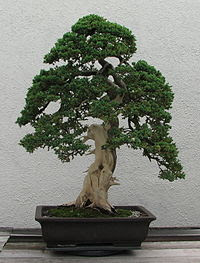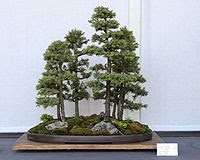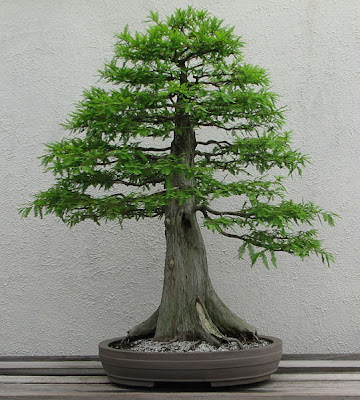- The formal upright style, or Chokkan is characterized by a straight trunk, upright, tapering. Branches progress steadily from the thicker and wider at the base of the finest and shortest at the top.
- Trunk and branches of the informal upright style, or Moyogi, with no visible curves, but the tip of the informal upright is always located directly above the cornice line of entry on the ground. Similar to the formal style vertical branches usually on a regular basis the progress of the largest at the bottom of the smallest on top, although this progression may be broken if the irregular shape of the hull would be a branch of exceptional importance or ambiguous.
 |
| Informal upright style Juniper |
- Slant style or Shakan, bonsai trunks just like those of bonsai grown in the formal upright style. But the slant style trunk show ground at an angle and the top of Bonsai will be positioned to the left or right of the base of the root.
- Cascade-style, or shoes, bonsai are modeled after trees that grow on the water or mountains. Tip of the tip of the structure or semi-cascade style, or Han shoes, bonsai extend just below the lip or a bonsai pot, top (full) cascade style falls below the flat bottom.
 |
| Cascade style conifer |
- Raft style, or Netsuranari, bonsai mimic a natural phenomenon that occurs when the tree falls on your side, for example, erosion or other natural forces. Branches in the upper body, continue to grow in a number of new frames. Sometimes the roots are developing parts of the body was buried. Raft-style bonsai can have sinuous, straight, oblique or trunks, all giving the illusion that they are a group of separate trees, when in reality the branches of a tree planted on its side.
- The literati style, or bunjin-gi, bonsai is characterized by a trunk line usually naked, with branches reduced to a minimum and usually placed in the top of the trunk often twisted time. This style takes its name from Chinese scholars created Chinese brush paintings such as those found in the ancient text, The Mustard Seed Garden Manual of Painting. Its minimalist landscapes often depicted trees growing in harsh conditions, with twisted trunks and low foliage. In Japan, the literati style is known as bunjin-gi (文人 木). (Bunjin is a translation of the Chinese Wenran phrase meaning "scholars practiced in the arts" and gi is a derivative of the Japanese word, ki, for "tree").
- The group or forest style, or Yose Ue, comprises a planting of several trees or more, and generally an odd number in a bonsai pot. Trees are generally similar, with a variety of heights employed to add visual interest and to reflect the age differences encountered in mature forests.
 |
| Forest style |
- The broom style, or Hokidachi is used for large trees, thin branches, often with species like elms. The trunk is straight and honest. Branches in all directions over a third of the height in the entire height of the tree. The branches and leaves form a crown-shaped ball, which can also be very beautiful during the winter months.
 |
| Broom Style |
- The multi-trunk style, or Ikadabuki, it all stems that grow in a place with a root system, and is actually a single tree. His counterpart in nature is the group of trees formed, for example, when a pineapple has just sprung a number of plants in one place. All logs are combined to support a crown of leaves, where the thick trunk and a more developed form at the top.
 |
| Multi Trunk Style |
- Shari style, Sharimiki , the style is to paint a tree in his fight for life, while a significant portion of its trunk is just the bark. In nature, trees in the style Sharimiki created by lightning or animals from eating the bark.
 |
| Shari Style |
- The root-over-rock style, or root over rock style is where the roots of the tree is wrapped around a stone. Rock is at the base of the trunk with the roots exposed to varying degrees when they cross the rock and soil.
 |
| The Root Over a Rock |
- Grow-in-a-rock, and Ishizuka, style means the roots of trees grow in the soil into the cracks and holes in the rock. Rock may be a simple wooden container with the container and form its own form on the run. Wood can show a clear relationship between rock type, are still near the rock, and then outline.
 |
| Grow in a Rock Style |










